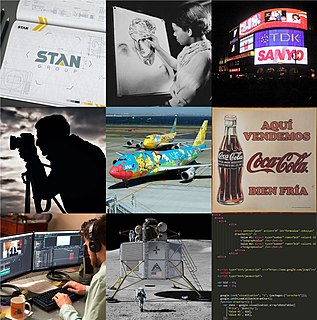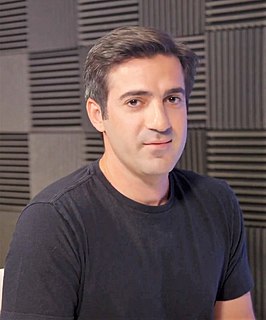Related Research Articles

Graphic design is the profession and academic discipline whose activity consists in projecting visual communications intended to transmit specific messages to social groups, with specific objectives. Therefore, it is an interdisciplinary branch of design whose foundations and objectives revolve around the definition of problems and the determination of objectives for decision-making, through creativity, innovation and lateral thinking along with digital tools, transforming them for proper interpretation. This activity helps in the optimization of graphic communications (see also communication design). It is also known as visual communication design, visual design or editorial design.
Multimedia is a form of communication that combines different content forms such as text, audio, images, animations, or video into a single presentation, in contrast to traditional mass media, such as printed material or audio recordings. Popular examples of multimedia include video podcasts, audio slideshows and Animated videos.

The Compact Disc-Interactive is a digital optical disc data storage format that was mostly developed and marketed by Dutch company Philips. It was created as an extension of CDDA and CD-ROM and specified in the Green Book, co-developed by Philips and Sony, to combine audio, text and graphics. The two companies initially expected to impact the education/training, point of sale, and home entertainment industries, but CD-i eventually became best known for its video games.

Digital signage is a sub-segment of electronic signage. Digital displays use technologies such as LCD, LED, projection and e-paper to display digital images, video, web pages, weather data, restaurant menus, or text. They can be found in public spaces, transportation systems, museums, stadiums, retail stores, hotels, restaurants and corporate buildings etc., to provide wayfinding, exhibitions, marketing and outdoor advertising. They are used as a network of electronic displays that are centrally managed and individually addressable for the display of text, animated or video messages for advertising, information, entertainment and merchandising to targeted audiences.

The Antirom art collective was formed in 1994 as a "protest against ill-conceived point-and-click 3D interfaces grafted onto re-purposed old content - video, text, images, audio and so on - and repackaged as multimedia". Its initial and most notable project, the Antirom CD-ROM, was funded by Arts Council of Great Britain and focussed on exploring interactivity in its own right, rather than being an interface to existing content such as video, audio and text. The group's process included producing many small interactive 'toys' that revolved around a single idea such as sound mixing, bouncing or scrolling elements. In the context of multimedia, at the time, this was a very different approach to the dominant "encyclopaedia" format such as Encarta. Antirom influenced several other designers such as Brendan Dawes who said of the group, "these guys changed things. Nothing was the same in the world of so called multimedia ever again. I remember seeing the amazing, different work for Levi's, which had a massive impact on me."
Digital Café was a new media company founded in early 1991 by Dean Hyers and Mike Koenigs. It operated for 7 years independently in St. Paul before being acquired in October 1998 as a new Minneapolis-based division of Campbell Mithun Esty specializing in programming and design for special-market advertising similar to Black Widow Games. In 1995, Hyers and Koenigs formed a sister company to Digital Café called Digital Entertainment as a joint venture with Navarre Corporation. Digital Entertainment was then sold to Navarre Corporation in 1996.
A production artist is a technical and creative position in a creative profession. The job title originated at advertising agencies, assigning what was known as paste-up work to the position. Production artists work closely with the designer and art director to execute the design. What distinguishes "production art" from design is opportunities to utilize prepress knowledge into creativity and design training in the work involved. The degree of technical knowledge required for some production art work may be comparable to higher skilled engineering, especially with computers.
The Graphex National Design Awards is a biennial competition in Canada to celebrate and showcase the best examples of visual communication design. It was founded in 1977 by the Society of Graphic Designers of Canada. Awards are given to creative professionals from various design disciplines in following categories:
Gaumina is the largest interactive agency in the Baltics, providing services of web design, web development, online advertising, video, multimedia, mobile and viral.

The British Fashion Council (BFC) is a not-for-profit organisation that harnesses the collective power of the industry to enable sustainable growth and strengthen British fashion in the global fashion economy. Founded in 1983, the BFC organises biannual womenswear and menswear showcases, London Fashion Week (LFW) and London Fashion Week Men's (LFWM) promotes the best of British design to an international audience.

Martin John Lambie-Nairn was an English designer. He was the founder of his branding agency Lambie-Nairn and was the creative director of branding agency ML-N. He is recognised for having redefined television brand identity design, being the first to embrace computer technologies to apply branding to screen-based media.
Nicolas Roope is a British industrial and digital media designer and entrepreneur.

Helen Storey, MBE, RDI, FRSA is a British artist and designer living and working in London. She is Professor of Fashion Science at the University of the Arts, London and Co-Director of The Helen Storey Foundation.
Craig Michael Oldham is a British designer based in the UK. Oldham has produced design work in design, film, television, art, retail, sports, entertainment, and education.
Ruptly GmbH is a Russian video news agency specializing in video-on-demand, based in Berlin, Germany. It is a subsidiary of the Russian state-controlled television network RT. Ruptly runs the media channel Redfish and is the major shareholder of Maffick. It provides video content to various news providers.

Dr Neil Hillman is a British television and feature film sound designer and editor, notable for his work on the Oscar-winning film Lincoln, New York I Love You and Grace of Monaco. Hillman was awarded the World Medal for Sound Design at the New York Festival for the film The 13th Day in 2010 and in November 2010 was awarded the Royal Television Society award for Best Production Craft Skills for Sound Design and Mixing on the film Handle With Care.
Christine Losecaat van NouhuysMBE, FRSA, is an internationally experienced senior business strategy, creative, marketing and communications specialist.

Rus Yusupov is an American designer and tech entrepreneur. He is best known as the co-founder of Vine and the co-founder and CEO of HQ Trivia, a daily, appointment-based trivia game that was broadcast live to mobile phones.

ZOO Digital Group PLC is a provider of cloud software based subtitling, dubbing and media localization services to the TV and movie industry. Its production facilities are located in El Segundo, Los Angeles; London and Sheffield, UK and Dubai, U.A.E. The company employs more than 200 employees worldwide and utilizes a global network of over 5,000 freelance translators and dubbing artists.

The Temporary Contact Numbers Protocol, or TCN Protocol, is an open source, decentralized, anonymous exposure alert protocol developed by Covid Watch in response to the COVID-19 pandemic. The Covid Watch team, started as an independent research collaboration between Stanford University and the University of Waterloo was the first in the world to publish a white paper, develop, and open source fully anonymous Bluetooth exposure alert technology in collaboration with CoEpi after writing a blog post on the topic in early March.
References
- ↑ Montgomery, Angus (2012-11-12). "Tom Roope and Brian Eno among new Royal Designers for Industry". Design Week. Retrieved 2020-09-02.
- ↑ "Honorary Graduates | Alumni Community | University of Lincoln". www.lincoln.ac.uk. Retrieved 2020-09-02.
- ↑ sass (2008-02-10). "Anti-rom". Mute. Retrieved 2020-09-03.
- ↑ Grafik. "Anti Heroes". Grafik. Retrieved 2020-09-02.
- ↑ "In the beginning there was Antirom | Digital Archaeology" . Retrieved 2020-09-03.
- ↑ Pendrell, Luke (2014-07-03). "Digital Revolution (antirom)".Cite journal requires
|journal=(help) - ↑ Campbell-Johnston, Rachel. "Here's something my robot made earlier — the new age of digital art". ISSN 0140-0460 . Retrieved 2020-09-02.
- ↑ "#iamabroadcaster Preview: Tom Roope, The Rumpus Room | AIB". aib.org.uk. Retrieved 2020-12-04.
- ↑ "How Google Zoo is thinking about machine learning". Current Daily. 2018-02-23. Retrieved 2020-08-27.
- ↑ "Google launches hieroglyphics translator powered by AI". BBC News. 2020-07-15. Retrieved 2020-08-27.
This article needs additional or more specific categories .(December 2020) |